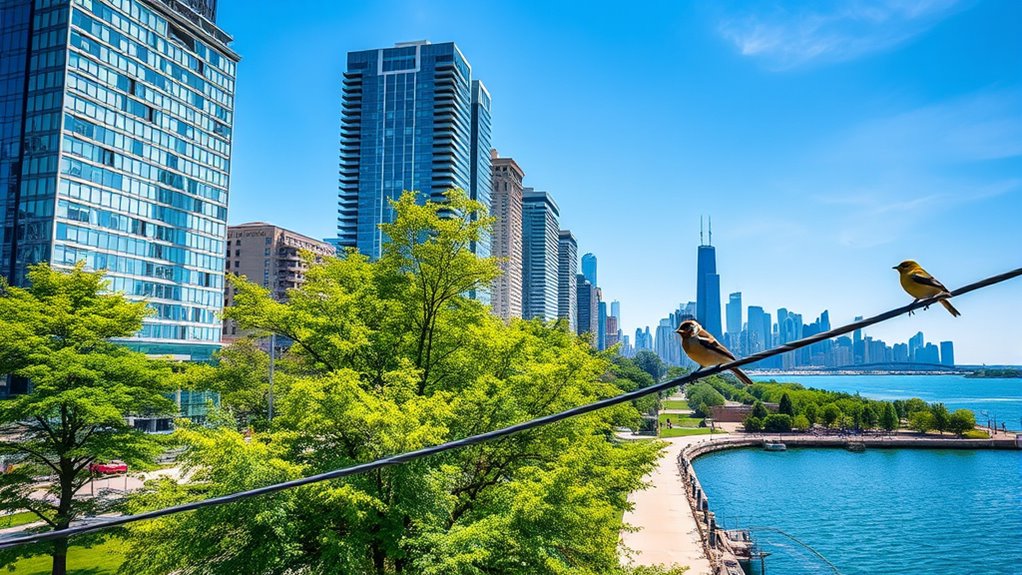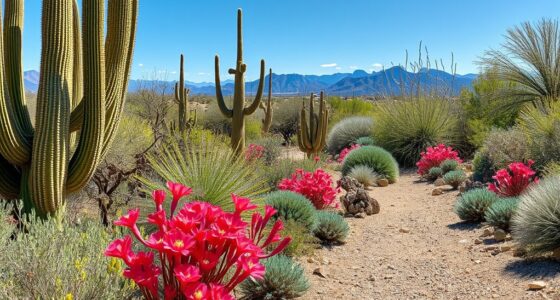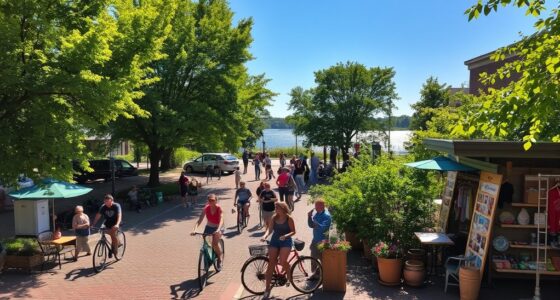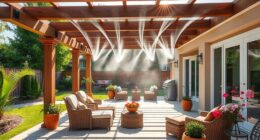Chicago is a fantastic city for urban birding, with hotspots like Lincoln Park Zoo, Jackson Park, and Montrose Point serving as prime spots to see a variety of birds. The lakefront shoreline, Humboldt Park, and the Chicago Botanic Garden also attract migrating and resident species year-round. Birders of all levels will find plenty to observe, especially during spring and fall migrations. Explore further to discover more about these vibrant birding locations and their seasonal highlights.
Key Takeaways
- Lincoln Park Zoo, Chicago Botanic Garden, and North Park Village are prime urban birding locations supporting conservation efforts.
- Parks like Jackson Park, Humboldt Park, and Burnham Park host diverse species during migration seasons.
- Montrose Point Bird Sanctuary and Eggers Grove Preserve are critical stopovers for migrating birds.
- Peak bird activity occurs in spring and fall, especially early mornings during migration periods.
- Habitat diversity across wetlands, woodlands, and open spaces enhances birdwatching opportunities throughout the city.
Lincoln Park Zoo and Conservatory
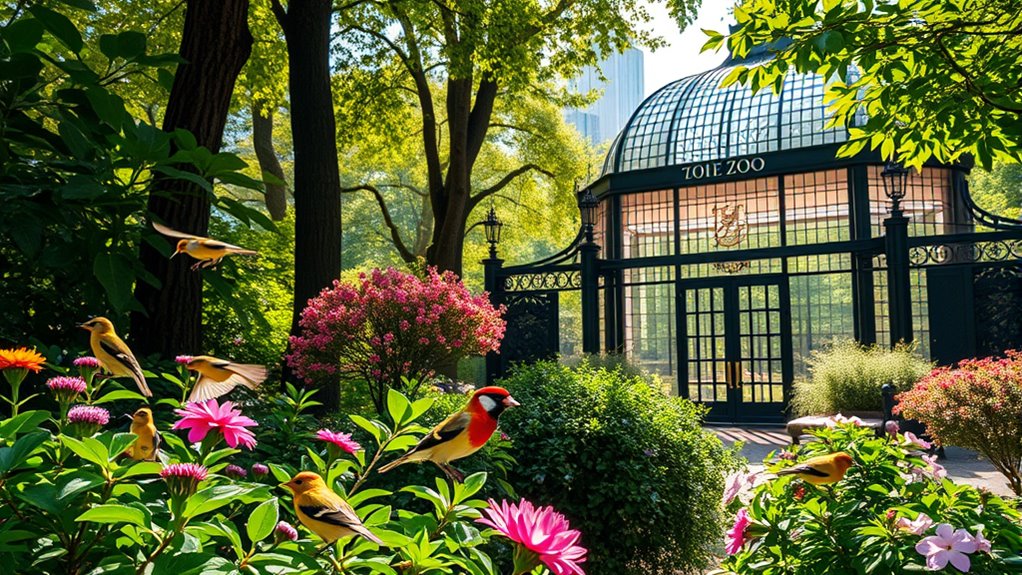
Have you ever wondered where urban birdwatchers flock in Chicago? The Lincoln Park Zoo and Conservatory are prime spots for observing urban nesting behaviors. Here, many bird species take advantage of the lush landscapes, making it an ideal location for spotting urban nesting sites. The zoo actively participates in conservation efforts, working to protect local bird populations and their habitats. As a birdwatcher, you can witness firsthand how these efforts support the city’s avian diversity. The conservatory’s gardens and the zoo’s natural areas offer a peaceful setting for observing birds that thrive amid city life. Visiting these spots not only enhances your birding experience but also contributes to ongoing conservation initiatives aimed at safeguarding Chicago’s urban bird populations.
Jackson Park and the Midway Plaisance
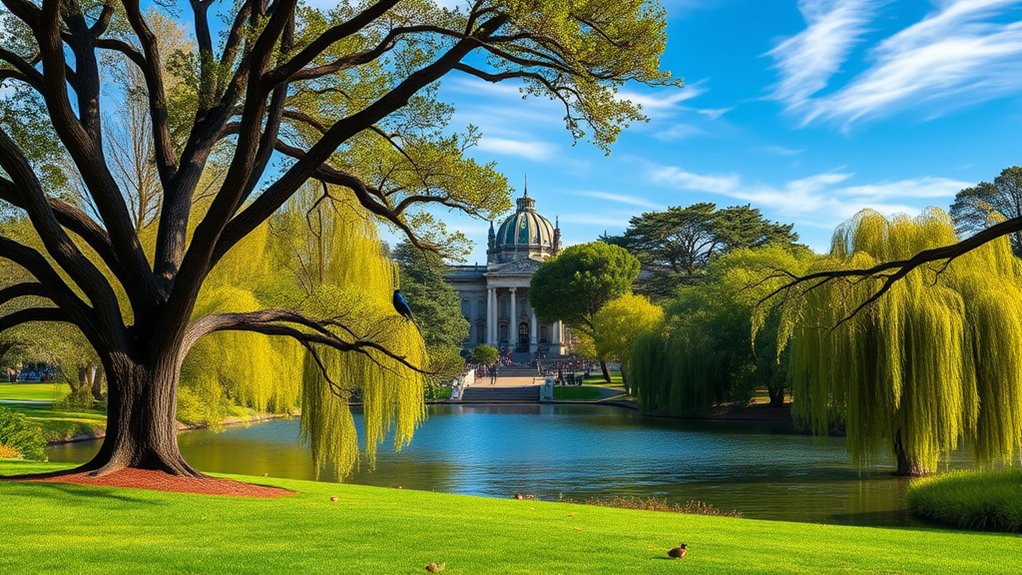
Jackson Park and the Midway Plaisance host a wide variety of bird species, making them excellent spots for urban birding. The best times to observe are early mornings and during spring and fall migrations. Nearby locations like the Jackson Park Lagoon and Wooded Island also offer prime birding opportunities. Additionally, observing local bird populations can provide insights into seasonal migration patterns and habitat diversity.
Bird Species Diversity in Jackson Park
Bird species diversity in Jackson Park and the Midway Plaisance showcases the area’s rich ecological variety, attracting both casual birdwatchers and dedicated enthusiasts. During bird migration seasons, you’ll notice a surge of species passing through, taking advantage of the park’s diverse habitats. Urban nesting also contributes to this diversity, as many birds have adapted to nesting in trees, shrubs, and even man-made structures within the park. You might spot species like red-winged blackbirds, nuthatches, and chickadees, which thrive amid the park’s mix of wetlands, open spaces, and wooded areas. This variety creates a vibrant birding environment where you can observe different behaviors and interactions. Jackson Park’s ecological richness makes it a prime spot to experience the full spectrum of urban birdlife. The park’s accessibility and amenities further enhance its appeal for bird enthusiasts.
Best Viewing Times and Seasons
The best times to observe birds at Jackson Park and the Midway Plaisance are during early mornings and late afternoons when activity peaks. During these periods, you’ll catch the most bird movements, especially during seasonal migration. Early mornings are ideal for spotting species arriving or departing, as many birds are active at dawn. Late afternoons also offer good viewing, with birds settling in or preparing to roost. To maximize your birding experience, consider these tips:
- Visit during peak migration seasons in spring and fall
- Watch for flocks forming in the early morning light
- Pay attention to weather changes, which influence bird activity
- Use binoculars for better visibility during busy migration times
- Keep a journal of observed species during different seasons
- The presence of urban parks like Jackson Park and the Midway Plaisance can attract a variety of bird species, making timing and seasonality crucial for successful birding.
Timing your visits enhances your chances of witnessing vibrant bird activity.
Notable Birding Spots Nearby
If you’re looking to explore prime birding locations near downtown Chicago, Jackson Park and the Midway Plaisance stand out as accessible and diverse spots. These areas benefit from thoughtful urban planning that balances recreation with bird conservation efforts. Jackson Park, with its mix of wetlands, open water, and wooded areas, attracts a variety of waterfowl, songbirds, and raptors. The Midway Plaisance offers a more open landscape, supporting migrating birds and urban wildlife. Both sites showcase how well-designed green spaces can promote bird conservation within a city. As you bird, you’ll notice how urban planning enhances habitat diversity, making these spots ideal for both casual birders and serious enthusiasts alike. These parks prove that urban environments can support thriving bird populations with proper design and dedication, illustrating the importance of habitat diversity in supporting urban wildlife.
Montrose Point Bird Sanctuary
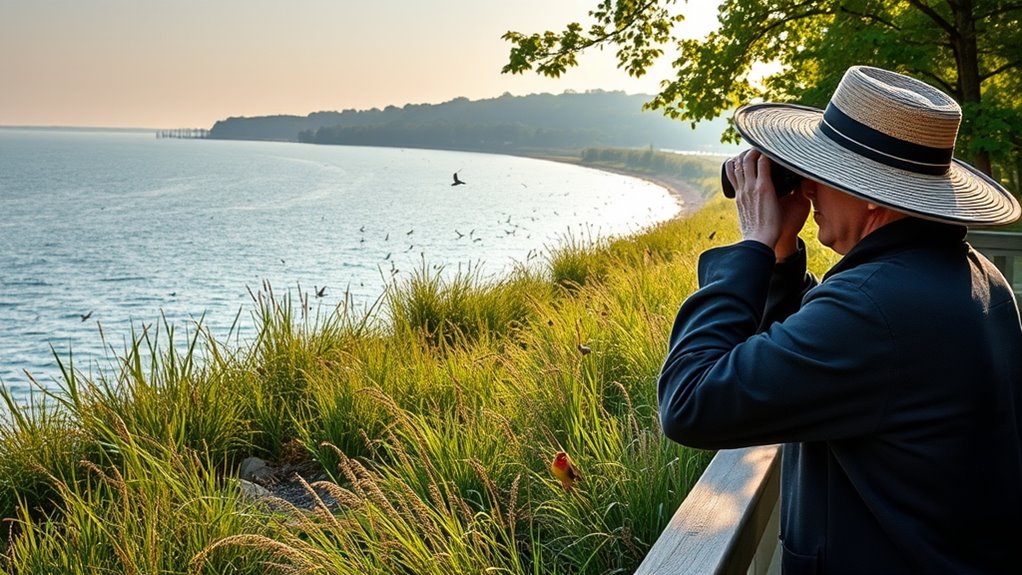
At Montrose Point Bird Sanctuary, you’ll notice a wide variety of bird species throughout the year. The best times to observe this diversity are during migration seasons in spring and fall. Visiting during early mornings or late afternoons will give you the best chances to spot different birds. Additionally, understanding bird migration patterns can enhance your birding experience.
Bird Species Diversity
Montrose Point Bird Sanctuary stands out as a vibrant hub for bird species diversity in Chicago, attracting a wide variety of avian visitors throughout the year. You’ll notice a mix of resident birds and those following migratory patterns, creating a dynamic environment. The sanctuary’s diverse habitats support urban nesting for many species, including warblers, sparrows, and gulls. During migration, it becomes a critical stopover point, increasing species richness. You can observe:
- A wide array of songbirds during spring and fall
- Raptors soaring overhead
- Waterfowl in the ponds
- Shorebirds along the shoreline
- Urban nesting sites for species like gulls and pigeons
This diversity makes Montrose Point a must-visit for bird enthusiasts enthusiastic to witness the full spectrum of Chicago’s avian life. Additionally, understanding decoding slang can help visitors better interpret bird calls and behaviors, enriching their birding experience.
Best Birding Times
The best times to observe birds at Montrose Point Bird Sanctuary are during spring and fall migrations, when a wide variety of species pass through the area. During these periods, migration patterns bring large flocks overhead, increasing your chances of spotting diverse birds. Early mornings and late afternoons are ideal, as many birds are actively feeding and restocking energy for their journeys. Pay attention to feeding behavior, which varies with the season; in spring, birds focus on building energy reserves, while in fall, they bulk up before migration. Migrants often stop at Montrose Point to forage, making it a prime spot for observing feeding behavior and migration in action. Planning your visits around these times will maximize your birding experience. Additionally, the effectiveness of hydrocolloid patches highlights how certain natural ingredients can support skin during active observation days.
Humboldt Park and Lagoon
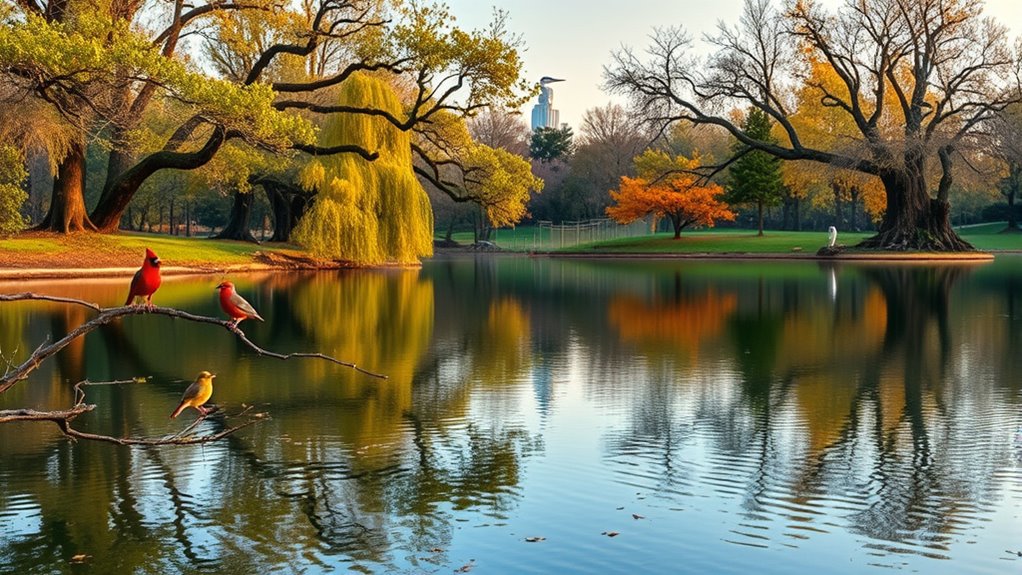
Have you ever wondered where to spot a diverse array of birds in Chicago? Humboldt Park and its lagoon offer excellent opportunities for urban nesting and observing lagoon ecology. The park’s wetlands and shoreline attract species like herons, ducks, and gulls. During migration seasons, you might see songbirds resting in trees nearby. The lagoon’s shallow waters support aquatic insects, drawing insectivorous birds. You can also spot raptors hunting over the open water or perching along the shoreline. The park’s diverse habitats create a perfect setting for birding enthusiasts. Keep an eye out for:
Explore Humboldt Park’s wetlands and shoreline for diverse bird species like herons, ducks, songbirds, and raptors.
- Great blue herons wading in the lagoon
- Mallards and wood ducks on the water
- Songbirds nesting in nearby trees
- Raptors soaring above
- Shorebirds along the shoreline
Additionally, understanding bird migration patterns can enhance your birdwatching experience during peak seasons.
Chicago Botanic Garden
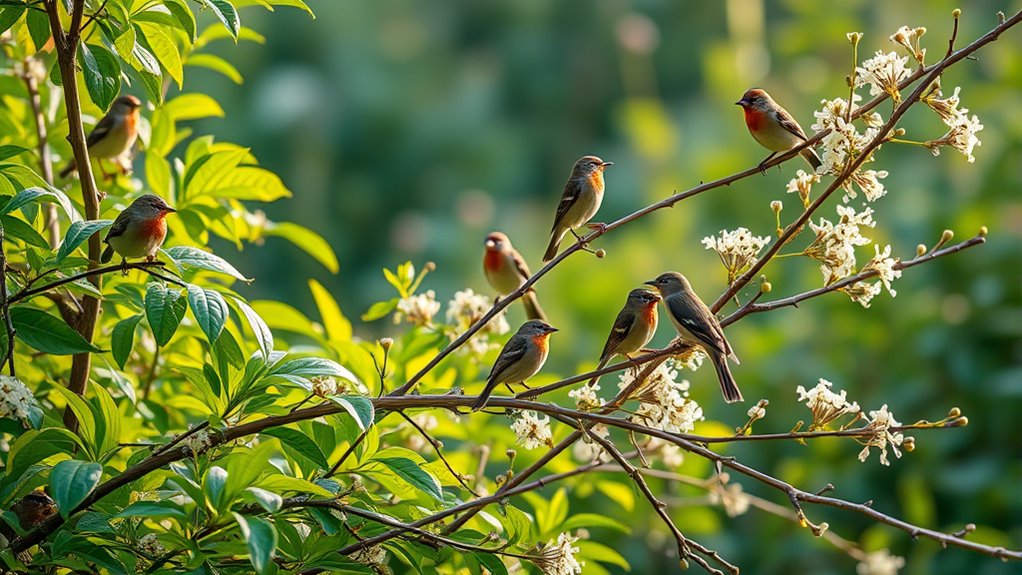
Moving from Humboldt Park’s shoreline habitats to the lush landscapes of Chicago Botanic Garden reveals a different but equally vibrant birding experience. Here, you’ll find a well-maintained urban garden that offers a sanctuary for native species and migrating birds alike. The diverse habitats within the garden—wetlands, meadows, and wooded areas—attract a variety of species, from warblers to sparrows. As you explore, stay alert for colorful finches and delicate warblers flitting through native plants and trees. The garden’s focus on native species helps support local bird populations, making it a prime spot for observing familiar birds in a peaceful setting. Whether you’re a seasoned birder or a casual observer, Chicago Botanic Garden provides a rich, accessible destination for urban birding.
North Park Village Nature Center
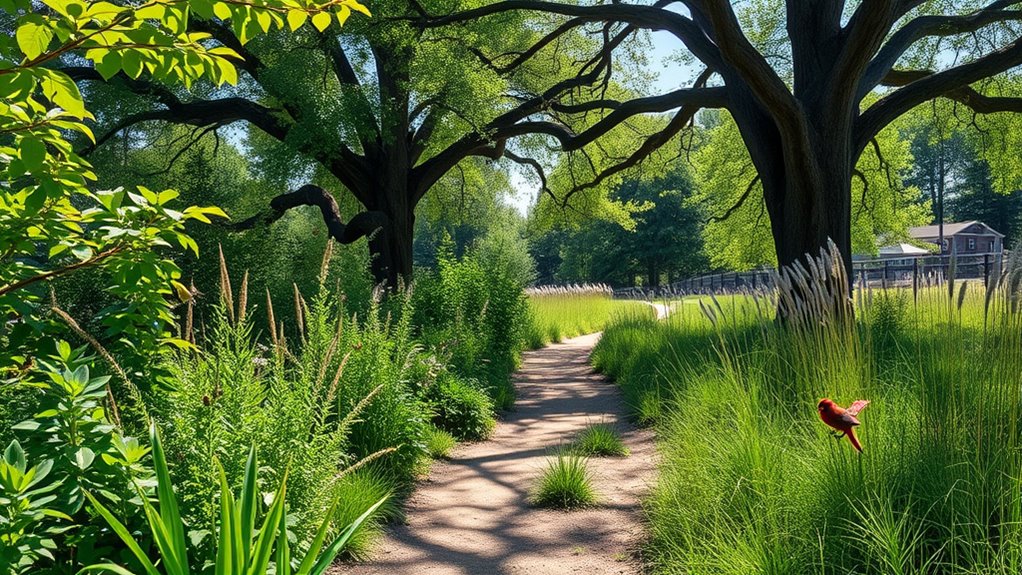
Ever wondered where to find a peaceful oasis for urban birding in Chicago? North Park Village Nature Center offers a perfect spot to observe urban ecology in action. This nature reserve attracts a variety of bird species, especially during migration seasons. You’ll enjoy exploring its diverse habitats, from woodlands to wetlands, which support local and migratory birds alike. As you walk the trails, keep an eye out for songbirds, woodpeckers, and waterfowl. The center also provides educational programs about bird migration and habitat conservation. Whether you’re a beginner or experienced birder, this spot helps you connect with nature amid the city’s hustle. Prepare your binoculars and enjoy a peaceful retreat that highlights Chicago’s rich urban ecology. Make sure to check the camping resources and guides to enhance your outdoor experience.
Burnham Park and Lakefront Trail
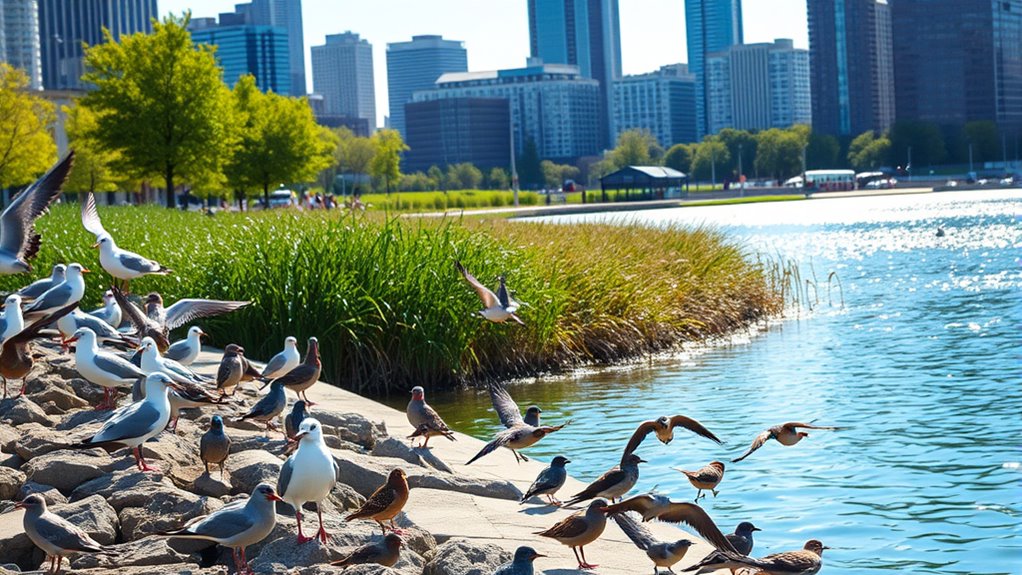
Burnham Park and the Lakefront Trail offer some of Chicago’s best bird diversity spots. You’ll find the most activity early in the morning and late afternoon, when many species are most active. Keep your binoculars ready to spot a variety of waterfowl and migratory birds along the shoreline. Utilizing proper identification techniques can enhance your birdwatching experience and help you distinguish between similar species.
Bird Diversity Along Lakefront
Have you ever wondered why Chicago’s lakefront attracts such a diverse array of bird species? The answer lies in its rich urban ecology and strategic location along migratory patterns. The Lakefront Trail and Burnham Park serve as crucial stopovers for migrating birds, offering food, shelter, and open water. During migration seasons, you might see:
- Waterfowl like ducks and swans taking advantage of the lakes
- Songbirds resting on trees along the trail
- Shorebirds foraging on beaches and rocky outcroppings
- Raptors soaring overhead, hunting for prey
- Urban-adapted species thriving in the park’s green spaces
This diversity results from Chicago’s unique position as a crossroads of migratory routes, making the lakefront an essential habitat for many bird species within urban ecology.
Best Viewing Times
To make the most of bird sightings along Chicago’s lakefront, it’s important to know when the best viewing times occur. During spring and fall migration, many species pass through, offering prime opportunities for birders. Early mornings, especially around dawn, are ideal because birds are most active feeding and singing. Pay attention to migration patterns—peak movements often happen just after sunrise, when birds settle into feeding habits after long flights. During migration seasons, you’ll see a variety of songbirds, waterfowl, and raptors. In summer, early evenings are productive as birds return to their nests or roosts. Understanding these timing windows helps you catch the most diverse and active birdlife, making your Chicago birding experience more rewarding.
Eggers Grove Forest Preserve

Eggers Grove Forest Preserve offers a peaceful escape right within Chicago’s city limits, making it a prime spot for birding enthusiasts. The preserve features diverse native habitats that support a variety of bird species, making your visits rewarding. Thanks to ongoing conservation efforts, native plants thrive, attracting both migratory and resident birds. As you explore, you’ll notice:
Discover Chicago’s birding haven with diverse habitats and thriving native plants at Eggers Grove Forest Preserve.
- Rich woodlands and open fields
- Wetlands teeming with waterfowl
- Native flora providing food and shelter
- Bird-friendly trails for easy access
- Active conservation programs enhancing habitat quality
These efforts help maintain healthy ecosystems, ensuring a vibrant bird population. Eggers Grove’s blend of natural beauty and dedicated conservation makes it an essential stop for anyone passionate about urban birding.
Gompers Park and Forest Preserve
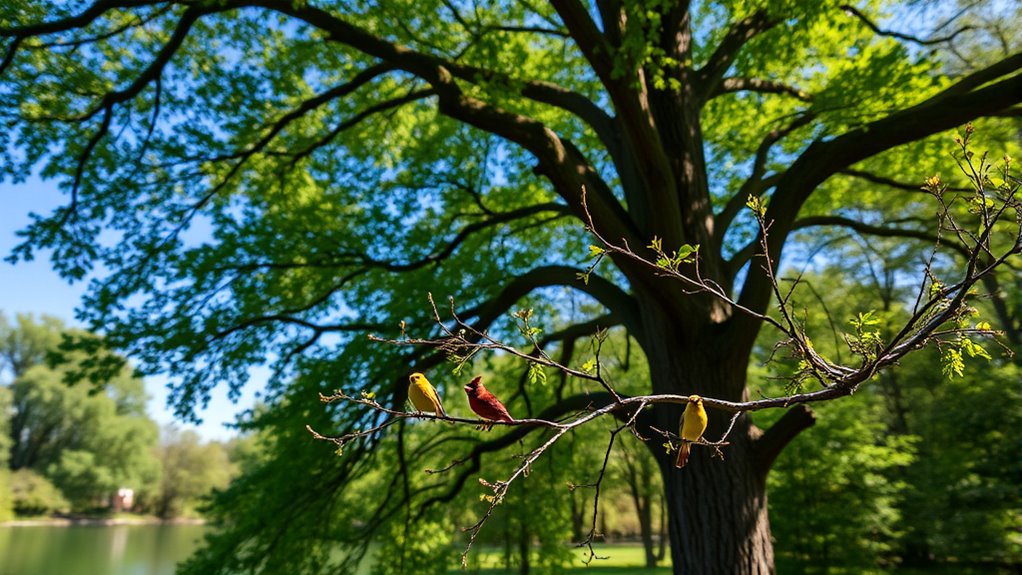
Gompers Park and Forest Preserve offers urban birders a vibrant destination just northwest of Chicago’s downtown area. The park features extensive native plantings that attract a variety of bird species, providing excellent opportunities for observation. Habitat restoration efforts have enhanced the preserve’s biodiversity, creating a welcoming environment for local and migratory birds alike. As you explore, you’ll notice how carefully maintained native plants support insects and other prey, drawing in songbirds, woodpeckers, and warblers. The combination of open fields, wooded areas, and restored habitats makes Gompers Park a prime spot for birding year-round. Whether you’re a beginner or an experienced birder, this urban oasis offers a chance to connect with nature and witness Chicago’s diverse avian population thriving amidst ongoing habitat restoration initiatives.
Ohio Street Beach and Lake Michigan Shoreline

Just beyond Gompers Park, the shoreline along Lake Michigan offers a dynamic birding experience at Ohio Street Beach. Here, you can observe urban nesting sites and shoreline migration patterns that draw a variety of species. During spring and fall, migrating birds stop along the shoreline, making it a prime spot for birdwatching. The mix of natural habitat and cityscape creates a unique environment for urban nesting. You might see gulls, terns, or even distant raptors soaring overhead. The constantly changing shoreline provides opportunities to spot less common migrants. Be alert for:
- Shorebirds during migration seasons
- Urban nesting colonies on nearby structures
- Gulls scavenging along the beach
- Raptors hunting over Lake Michigan
- Migrant songbirds in the trees
This hotspot combines city life with natural migration, enriching your birding experience.
Frequently Asked Questions
Which Bird Species Are Most Commonly Seen at Each Hotspot?
When you’re observing bird species at different hotspots, you’ll notice some birds are more common than others. To identify these birds, focus on key features like size, color, and song for accurate bird identification. By paying attention to these details, you can quickly recognize the most frequently seen bird species at each location. This approach makes bird watching more enjoyable and helps you learn about urban bird populations effectively.
What Is the Best Time of Year for Birding in Chicago?
Oh, the perfect time for birding in Chicago? Well, it’s during migration seasons when the city’s just bursting with feathered friends. You’ll love the buzz of bird banding events, where tiny explorers get their wings checked. Fall and spring are prime, offering a front-row seat to nature’s grand show. So, mark your calendar, grab your binoculars, and enjoy the seasonal spectacle Chicago’s avian parade has to offer!
Are Guided Birding Tours Available at These Locations?
Yes, you can find guided birding tours and birding workshops at many popular birding hotspots in Chicago. These tours are led by knowledgeable guides who help you spot and identify local bird species. Participating in guided birding tours enhances your experience, especially if you’re new to birding, and birding workshops offer valuable tips and skills. Check with local parks or birding organizations for schedules and availability to make the most of your birding adventures.
What Birding Equipment Is Recommended for Beginners?
Imagine you’re setting out on a scenic adventure; for birding, your binocular selection matters. Start with lightweight, waterproof binoculars with good magnification—these make spotting birds easier. A simple field guide tips you off on common species to look for, boosting your confidence. You don’t need fancy gear—just a comfortable, reliable pair that helps you enjoy the sights and sounds of nature’s feathered friends.
How Can I Identify Rare or Elusive Bird Species in Chicago?
To identify rare or elusive bird species in Chicago, focus on bird call identification and bird habitat preferences. Listen carefully to distinctive calls and songs, which often reveal species even when they’re hidden. Pay attention to where you see them; different birds prefer specific habitats like wetlands or woodlands. Use binoculars and a field guide to help confirm your observations, and stay patient, as spotting rarities often takes time and practice.
Conclusion
Now that you know these top birding spots in Chicago, are you ready to explore the city’s vibrant avian life? From lush parks to scenic lakeshores, each location offers unique opportunities to spot diverse birds. Whether you’re a seasoned birder or just starting out, Chicago’s urban hotspots invite you to discover and connect with nature right in the heart of the city. So, why not grab your binoculars and see what feathered friends you can find today?

